By a rough and possibly less than accurate calculation, I reckon that this is the 188th vintage and collectors column I have written and photographed for Model Boats magazine. I was minded to aim for a round 200, but after 16.5 years of pumping out 12 and sometimes even 18 columns per annum, my resolve has finally weakened. The day has dawned and I must begin my last final regular column for this magazine. After the last two months compilation of readers collectables, I thought that I really ought to make an effort to end on at least a bit of a high, so let’s start with a bit of history.
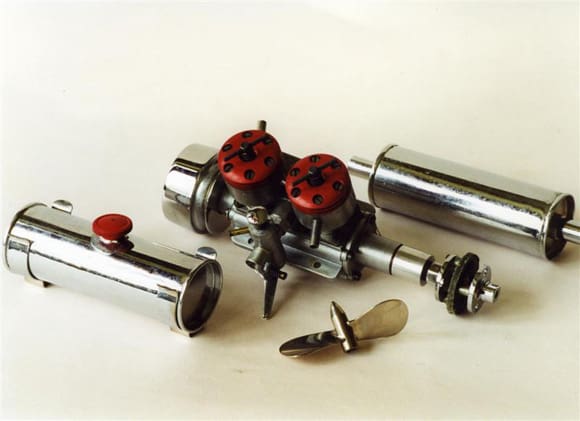
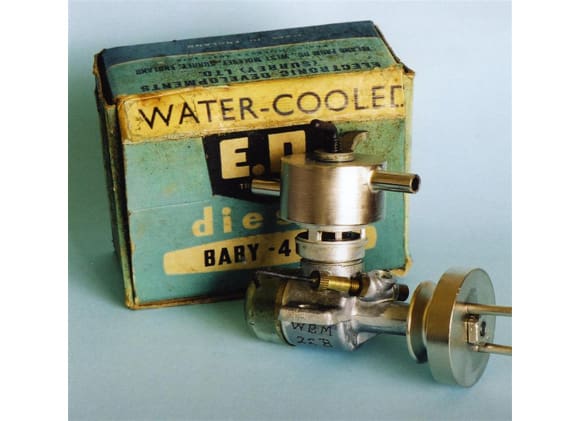
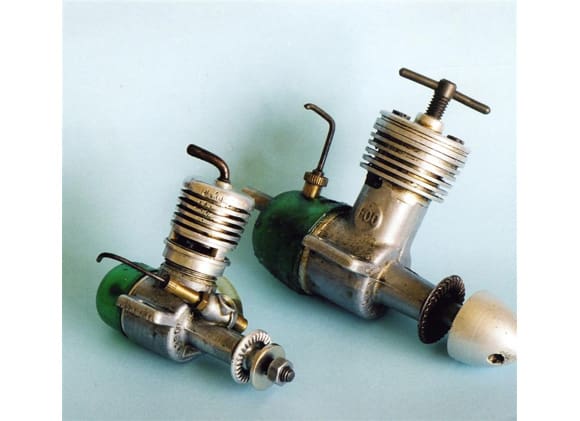
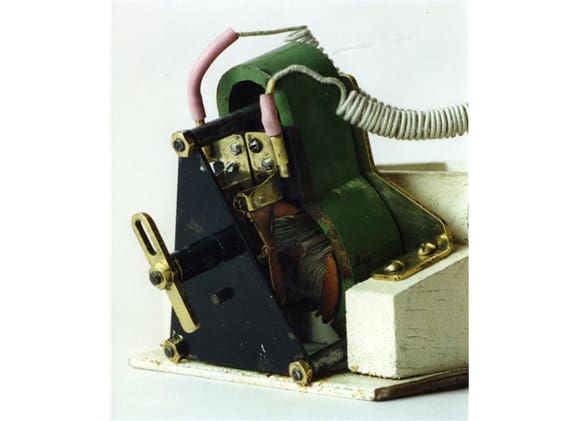
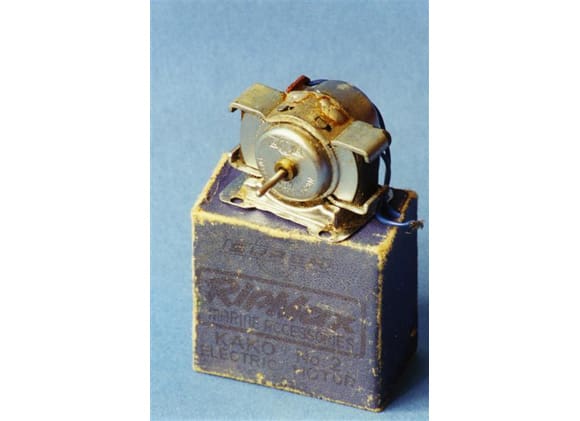
Pic 1: Once, becoming more experienced, the sixties model boater might aspire to owning something like this completely restored Taplin Twin Mk.II Deluxe 8cc double ended output shaft marine diesel, complete with tank, silencer and waterscrew. Pics 2 & 3: Small British diesel engines suitable for the new and just beginning boater of the sixties. A mint and boxed E.D. ‘Baby’ marine engine of 0.46cc capacity and air-cooled ‘Baby and ‘Bee’ (1cc) engines from the same manufacturer. Note the different induction methods, front rotary on the Baby and rear disc on the Bee. All of these engines retain their original plastic fuel tanks – a point to watch for when looking to purchase an example. Pics 4 & 5: If you couldn’t face internal combustion engines with their noise and dirt, there was always electric power. Performance was generally feeble and only suited to semi-scale craft. The larger Bassett Lowke motor is from the late 1930’s and the smaller Kako No.2 is Japanese from the 1960’s. Neither was particularly powerful. The Kako range was cheap and consequently popular. (My father built me a balsa wood Battle Class Destroyer in the 1960’s with such a motor, Editor)
In the beginning
I first met our long serving (and now happily retired) Editor, John Cundell, at the pond side on a visit to the lovely Mote Park lake at Maidstone, where the Cygnets Club of which John was then the secretary, pretty much reigned supreme on the southern r/c steering, speed and multi racing circuit of that era, the sixties and seventies. John was as successful as I was not! He was a very keen ‘Naviga’ steering competitor, whereas I was just a run of the mill enthusiastic clubster, using mostly home built single channel radio gear in non-competitive diesel powered, modified kit boats like the ‘Sea Commander’, before moving up to second-hand multi reed and early proportional radios in faster fibreglass planing hulls like Vic Smeed’s ‘Cachalot,’ moulded by Ray Blick.
Enjoy more Model Boats Magazine reading in the monthly magazine.
Click here to subscribe & save.
The differences in handling and sheer speed between a Sea Commander and a Blick Cachalot were huge, but I was young then and managed to master it. Further challenges came when I moved up from my trusty plodding ED Sea Otter to an Oliver Tiger racing engine in that hull. The Tiger was a full cubic centimetre (cc) less in capacity, but the boat was faster and harder to keep under control. Like John I enjoyed the challenge of speed-steering on the international Naviga Triangle and gamely ‘had a go’ in local regattas, but the main thing we had in common back then was that we were both club secretaries and hence needed to correspond by letter and phone (no email then readers), since our clubs Southend and Maidstone visited each others lakes on a regular basis. My abiding memory of these encounters is that they were rather one sided, meaning that while we had one or two competitive r/c chaps at Southend, I think it was our main role to stock the homes of Cygnets members with trophies!
When, as boredom relieving and pure fun at first, I began writing about radio control technology in 1989, it seemed natural for me to get in touch with John and offer MAP (as I think it still was then), what I was doing. He and they accepted and the rest is history (ha, ha)! I started in Radio Control Boat Modeller (RCBM) with a three part r/c electronics series that had previously won an award in ‘Electronic Technology’, a professional electronics journal, followed by ‘A Wireless in your Boat’ which ran for two years until it and I were transferred to ‘Model Boats’, when RCBM closed in late 1992. This column began in January 1993 and has appeared every issue since then. To be honest, maybe it is time to go and give the space to someone else now. So, if you are interested in submitting material on the vintage and collecting scene, here’s your chance. It would be nice if you were an active collector as I was myself, when I began this column (once retired from my mainstream career I found it difficult to afford continued collecting), for that way you are up to date with what is and is not being sought and with saleroom and general values.
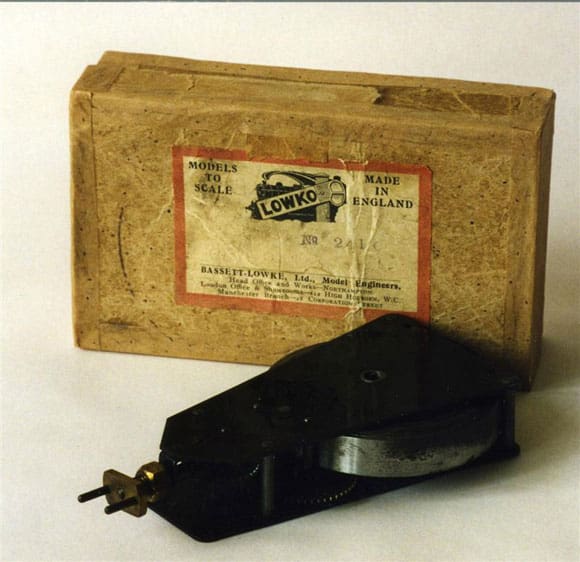
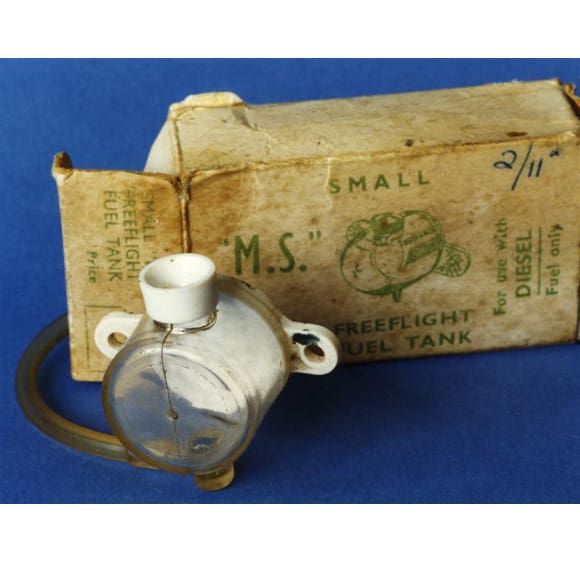
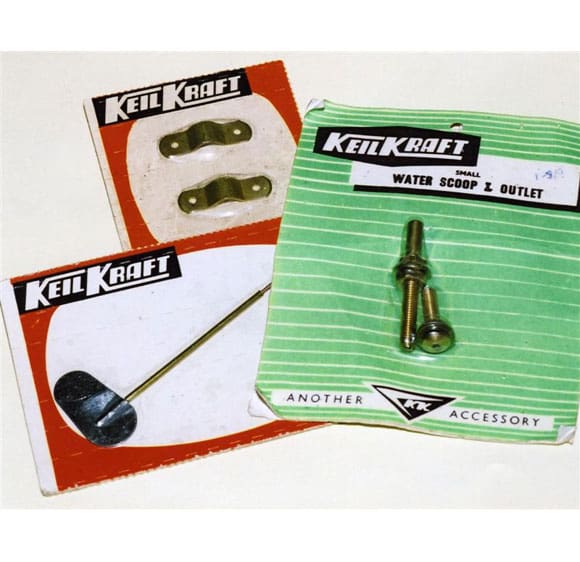
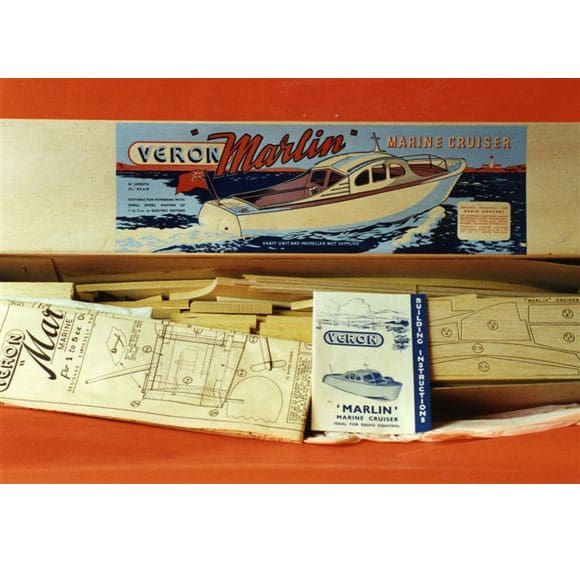
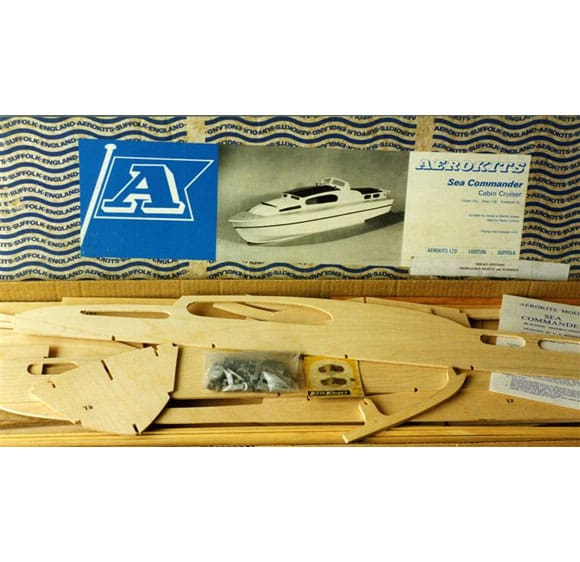
Pic 6: This is a clockwork spring motor for marine use from the 1930’s, ‘Lowko’ brand and still available into the 1950’s. Pics 7 & 8: A few accessories were needed by the model boater if he wanted to use a diesel engine in his boat. Here is a small fuel tank and a selection of KeilKraft items. Pics 9 & 10: Two mint 1960’s kits from Veron, the Marlin and from Aerokits, the Sea Commander, Both build into models approx. 36ins long and suited to engines of 2.3cc-3.5cc, or electric power.
Another long term friend who has supported me on and off all these years is the professional marine artist, Colin Moore. When my brother and I were little, Colin’s parents were our next door neighbours. Two of his oils help conclude my column just as they have enlivened them on and off in the past. ’Bawleys making for the Leigh Buoy’ and ‘Blue Flue off Tilbury’ are just so typical of his Essex based picture output, being sail and steam respectively. I have purchased a few of his works in years gone past and they decorate my home. I know that several readers, having seen Colin’s work in my column, have done the same. My best loved example of his work was commissioned by me some years ago and depicts the paddler ‘Medway Queen’, the heroine of Dunkirk no less, pulling away from Southend Pier on a lovely summers day about 1960, when I was myself still a schoolboy. This hangs in my home and never fails to cheer me up as the scene is so very familiar to me. A day aboard the ‘Waverley’ now, brings the old days back each and every autumn when she returns to Southend Pier. Only a couple of months to go and she’s back once again. Who will be first to see her smoke – there she comes!
It all began with old engines and old motors, but what am I going to end with? Well, how about a sample of all the varied topics I have featured in 16 years of antiques and collectables, leaving aside my ‘Christmas Specials’ already highlighted in our January issue. All those years ago it was vintage motors and engines that fascinated me the most, I suppose and I would have to say that these made up the core of Collectors Corner for the first few years.
As I have only recently given large scale coverage to the biggest of vintage engines, Gannet and CI Special, I thought that I would choose my closing examples from the opposite end of the bhp range entirely. When I was a teenage modeller, I could afford only the smallest diesels and even one of those required careful saving. My chosen engines are a mint and boxed, watercooled E.D. ‘Baby’ (at 0.46cc, the smallest British marine engine as I recall), and an aero 1cc ‘Bee’ and ‘Baby’ combo. Just the job for a first boat, since both were as easy to start as little engines were in those days. I cannot end this column without showing an example of my personal favourite model engine of the period during which I was active and a brand that I have since become especially associated with as a restorer. A Dell/Wiggins restored 8cc MK.II Taplin-Twin Deluxe, with double ended drive shaft, Taplin fuel tank, silencer and a marine prop. Then, owning a Taplin was just a dream for me, but now and after a great deal of hard work and research over many past years, I have 9 of them and all just as nice as this one. I’m still looking for an Aero Taplin Twin, if anyone has an example hidden away surplus to requirements.
If you were getting on a bit and really couldn’t face the rigours of ‘infernal combustion’, there were alternatives, of which the most favoured was the small DC electric motor. Rather than show yet more Taycols (like Taplin engines we have had quite a few over the years, I admit), I am featuring two very different designs and years apart at that. The oldest is a simple three pole/horseshoe magnet equipped design by Bassett Lowke of Northampton. This is c1939 and from one of their famous motor boats. The other, so typical of the 60’s and 70’s, is a mass produced KAKO No.2 made in Japan and distributed by both Ripmax, as in the accompanying picture, and also by KeilKraft. The Kako range could never be described as ‘quality’, but they were cheap and reliable. Thousands were bought by hard up lads like me. I can still remember the slightly odd smell these motors made while running, but that’s impossible for me to put into words. The No.2 size was small – too small for main drive power really – but was often chosen by DIY radio builders as an actuator motor or for some such auxiliary task.
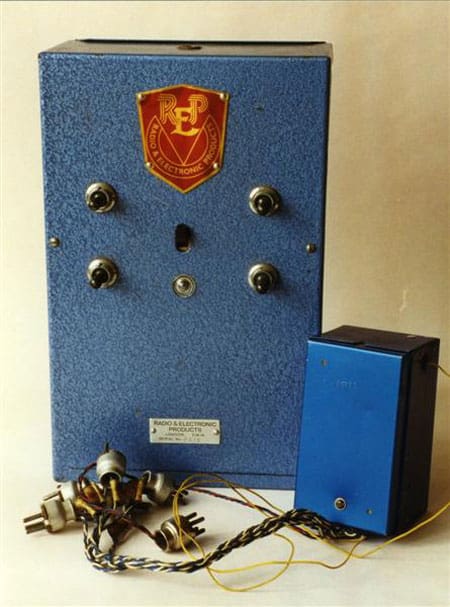
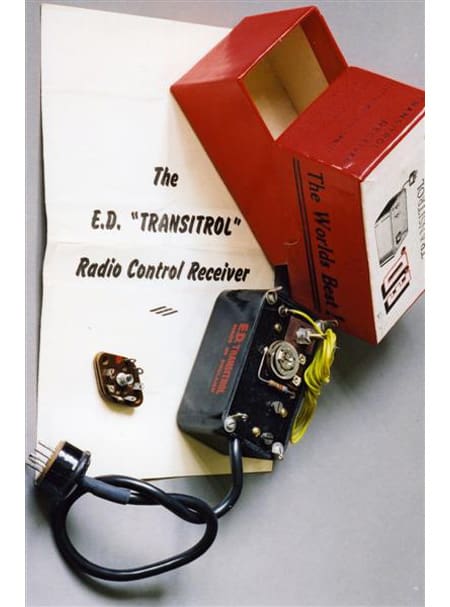
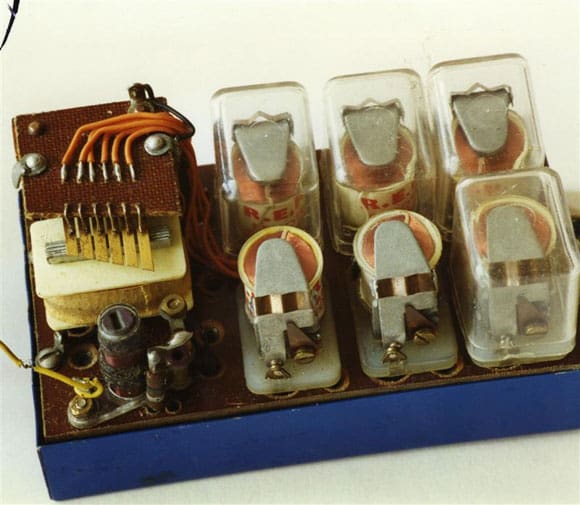
Pic 11: REP Octone Tx and Sextone Rx. Pics 12 & 13: E.D. Transitrol receiver, quite small for the period. These were state of the art for that time and widely used in radio control model boats.
Yet another alternative in very early model boat power was clockwork and I’m illustrating a Lowke (Bassett-Lowke) spring motor suited to small models only, say up to a 24in hull. There was also Jetex of course, but these tiny solid fuel gadgets were hardly up to propelling anything much over very lightweight tiny hulls and other than a few plans prepared by Vic Smeed, they were never a serious model boat power plant, certainly not once radio was considered. Steam was and is another matter altogether and ‘CC’ has featured the odd bit of steamery, both ancient and modern, over the years. As to rubber and clockwork propulsion, I have featured both in this column more than once, but they remain the only model motive power I’ve never actually tried. Both were a bit before my time really! Yes I have tried Jetex, but not in boats.
Accessories
Buying a motor or engine was never enough. There were always bits and bobs you required to fit it into your boat. Over the years I’ve tried hard to enthuse readers in seeking out the cheaper areas of collecting interest. Motors, engines, radio, kits and the rest will never be exactly cheap, but there are areas that can be, even free ones! On the whole, accessories are small, so take only a little display space, a big plus in a lot of modern homes. I’ve room for only two pictures here and have chosen a tiny ‘MS’ 1950’s made plastic fuel tank by KeelBild of Newcastle (two shillings and eleven pence and just right for an ED ‘Baby’ or ‘Bee’ engine) and a trio of bubble packed I.C. boat items from KeilKraft of Wickford. Any diesel user/boat kit builder would have needed a brass water scoop and outlet set (made in three sizes of which this is the smallest and again well suited to a ‘Baby’ or ‘Bee’ propelled little boat), a rudder (again, the smallest of the range), and a pair of cleats for prop. tube/keel fixing in something like a ‘Sea Rover’ or ‘Commander’.
For a boat kit
Right, so you’ve bought your engine or an electric motor. You have the necessary accessories to fit it. But you still need a boat! It is the sixties – yes, I wish it was as well, readers! You have radio control in mind when you have the money. You have been to the pond and chatted to the local boat fans and they have told you you’ll need at least a three foot long hull to get all that bulky r/c electricky gubbins in and at last you are ready to go window shopping at your local model shop. ‘A cabin cruiser, Sir? I have a choice of three – the Wavemaster by HMM, the Sea Commander by Aerokits and the Marlin from Veron’. Wow, where to go? Well, I think a lot would depend on your background.
If you were handy at carpentry, then HMM and Aerokits boats would have seemed very familiar. They were of all ply, wood, nails and glue technology, but if you had built any model aircraft, then the Veron offering would have almost sold itself, for it had lots of balsa, die cut and printed parts etc. I was myself inclined to Aerokits products. They were a bit cheaper and plainer than Veron (just compare the box tops for one thing), and in my opinion they were more rugged too. I think it’s fair to say that 50 years later, there are many more old Aerokits hulls surviving than there are Veron boats, but for prettiness you cannot beat the latter. A well made and painted Marlin or Police Launch is a lovely thing – why do you think I’ve kept this kit so long? But if you want a boat to use and use and abuse, week after week after week, then look no further than an old Aerokit – that’s my advice. ‘Goodness no Sir, that poor little ED Bee will be no good at all for one of these boats. Much too small!’ ‘If you like ED engines then you’ll need a ‘Hunter’. It’s good in two of them, if just a bit much for a Marlin. So why not settle for an ED Racer Sir, or a Frog 249? They are ideal for all of them and lovely engines as well, Sir. One day they are sure to be collectors classics as well!’
Needing a wireless for your boat?
And now for the big purchase. Remember, it’s 1960ish, you’ve saved a wad of money and my goodness, you are going to catch up with those other rich people at the lake and buy yourself some radio control gear at last. So, ‘Does Sir require single or multi channel?’ enquires the salesman.
Everyone has a ‘tranny’ at home (to get ‘The Luxy’ or pirate stations like Caroline or Radio London), the semiconductor transistor was just reaching model r/c gear and he has the latest ED ‘Transitrol’ receiver in stock. ‘All you need, is a clockwork escapement and a matching transmitter, plus a heap of batteries and you could be up and running with radio control this very weekend’, he suggests. ‘But of course, if Sir wishes to spend rather more – does Sir have a budget? Then here is the very, very latest in Reeds’. ‘Yes Sir, like the ED, the REP Sextone receiver does have transistors but a valve too, so you will still need HT and LT batteries, I’m afraid’. ‘Of course, the matching Octone Transmitter is all valve, four of them no less. Isn’t that blue steel case smart, Sir?’ Nobody said ‘cool’ back then readers, believe me. ‘Groovy’ or ‘hip’ yes, but never ‘cool’!
And so out you walked, the proud owner of a George Honnest-Redlich top of the range outfit, a boat kit and an engine, but a lot, lot poorer. You have dual-simultaneous controls with twin tone generators and gold plated reed and relay contacts throughout in that radio gear – boy-o-boy! It’s just the best UK made outfit anyone can buy, unless they really are a millionaire and can afford an imported Orbit, F&M, or Min-X all transistor and relayless rig, all the way from California. Or maybe perhaps one of the very first sets from Germany that were genuinely lightweight, solid-state and low voltage, having transistors instead of valves and tuned audio filters, instead of mechanical reeds (though still with relays). Sets like those from Telecont or Graupner were top of the range. These ‘solid state’ sets, whether from Europe or the USA and each with their own particular advantages over the other, really were the best you could buy at that time. Pretty ‘groovy’ gear as well!
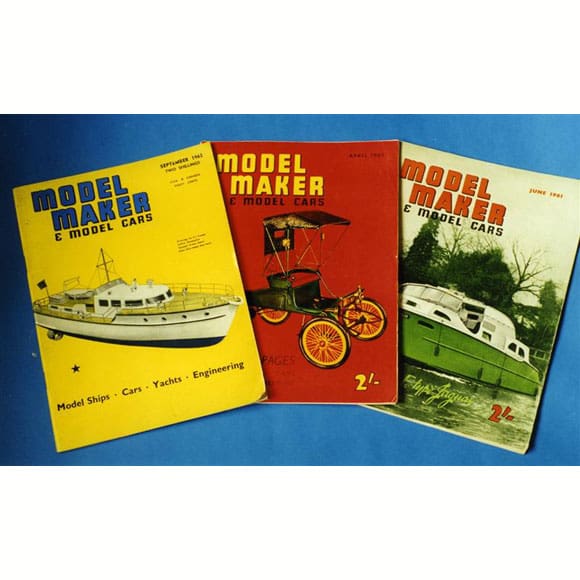
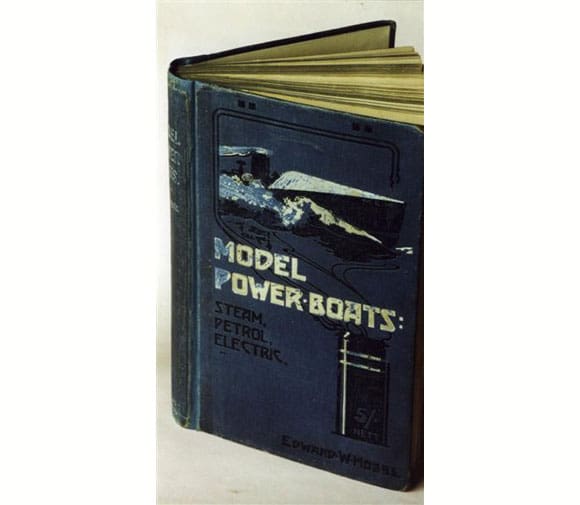
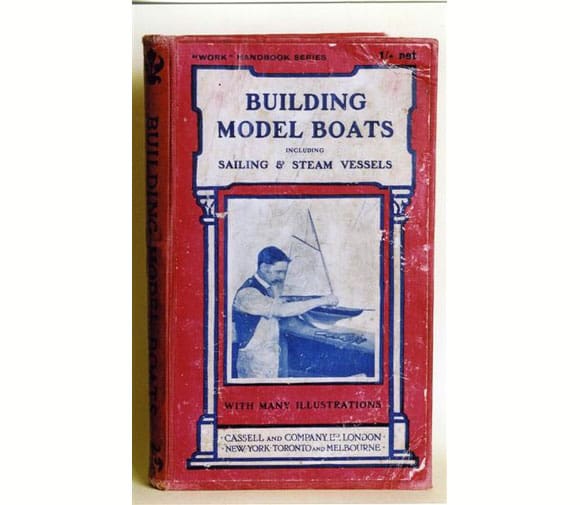
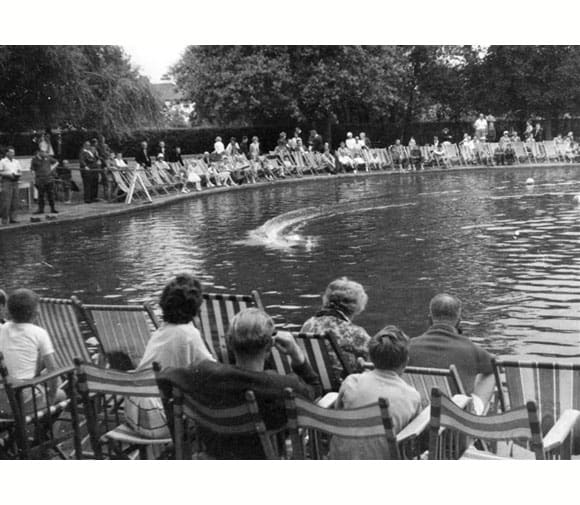
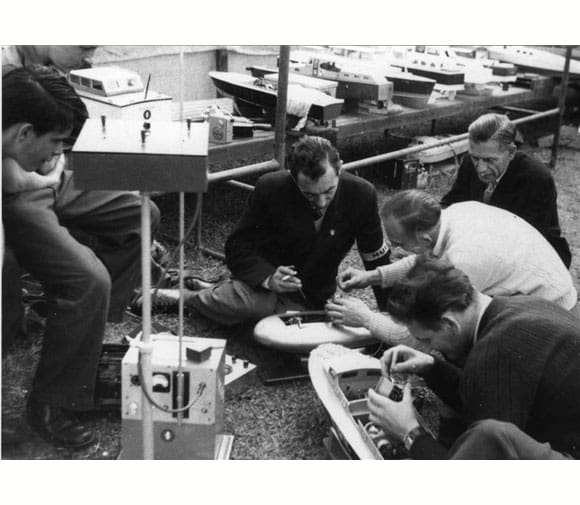
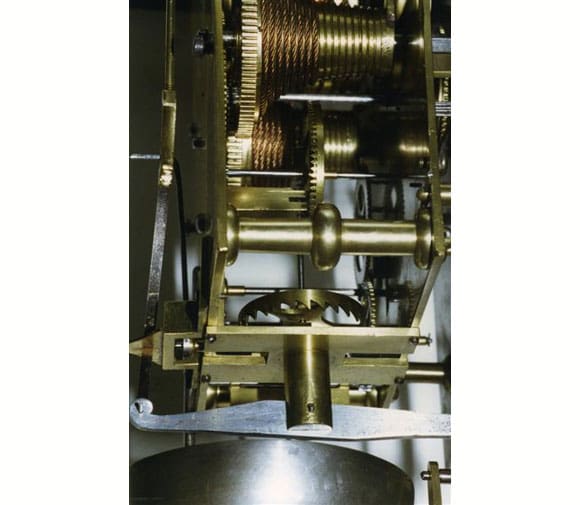
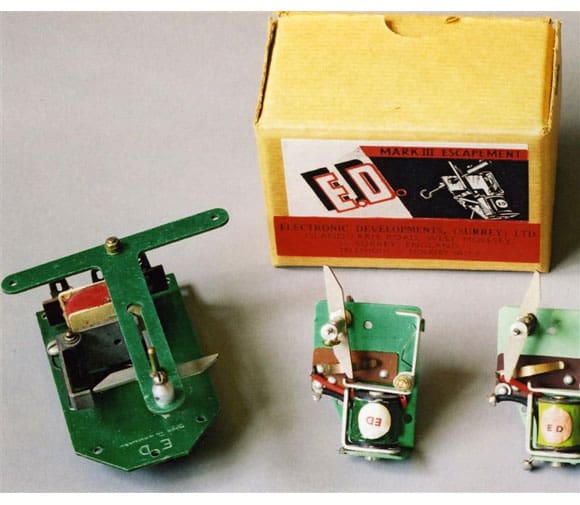
Pic 14: If you were taking up model boating seriously then the recommended magazine was Model Maker, edited by Vic Smeed. Price, price two shillings (10p now in decimal currency, there were 20 shillings to the pound). Pics 15 & 16: The 1960’s aspiring model boater would take a stroll to his local library looking for some useful books. These are a bit dated, but still have useful information. Pics 17 & 18: Two wonderfully atmospheric radio control regatta scenes from the early 1960’s. The first from Herne Bay and the second most likely from Kingston on Hull. Pics 19 & 20: The clock connection with model boats. Firstly there is a ‘verge’ escapement in a regency bracket clock c1800-1810. Secondly there is almost the full range of escapements by E.D., for boats, clockwork on the left and aeroplanes(rubber) are on the right.
Some reading matter
With technology changing as fast as it was back in the sixties, a chap really did have to keep-up on a monthly basis, via the model press.
I wrote earlier of less expensive and even free areas to collect in and I have featured vintage books and magazines many times in these pages. For anyone seeking vintage marine models to build, the old ‘Model Maker’, taken by every boater I knew back then, is unbeatable. The Editor/model designer Vic Smeed (see my May 2006 column), was prolific in his output over a very long period and for the most part, his boats were featured in the good old ‘MM’ Plans (free and otherwise), many of which are still available from various sources. If you see odd copies offered, then ‘buy them’ is the only advice I can offer. Over the last 16 years I have collected a fair few and some even have the original free plan still therein – amazing. And for just a pound or two each.
If it’s radio control that interests you, then search out the earliest copies of RCM&E is my advice. The small ones up to 1963 edited by Tommy Ives are the best. I bought a complete bound set (four volumes 1960-63), as one of my earliest purchases when I began writing and researching and it was the best buy I made. Old books on model boats (yes, and aeroplanes too) I always snap up, even if just for their terrific art covers as shown here. £5 to £10 is the most I think I’ve paid. So as I say, inexpensive, colourful and useful too. If like me you prefer the older designs, how can you lose at such prices?
Before going boating – vintage style!
Mere samples of what just must be thousands, I’ve found and featured over the years. I thought it would be nice to show you just a couple of atmospheric pictures from the long gone past of radio boating. What a happy scene is that at Memorial Park, Herne Bay, about 1960. A fast cabin cruiser is on the speed course and a good sized if not capacity crowd is agog and their cameras are out. At the other end of the country and a few years earlier still in the mid 1950’s, the Tyneside Group (I think) of the old IRCMS (International Radio Control Models Society), is tinkering and tuning in a Crash Tender hull, prior to going on the water. All that boat and radio building and testing has come to fruition and soon the boat will be twisting and turning on the water as if by magic – ‘Black Magic’ surely? Just look at the care that has gone into the huge ground standing transmitter and it’s whopping great control console. The 8ft 6ins high, ex WWII sectional tank antenna is clearly visible, as are all the boats in the background. I made such radio equipment myself beginning about 1962 and I bet they had a lovely if challenging day. Such memories and really good fun as well.
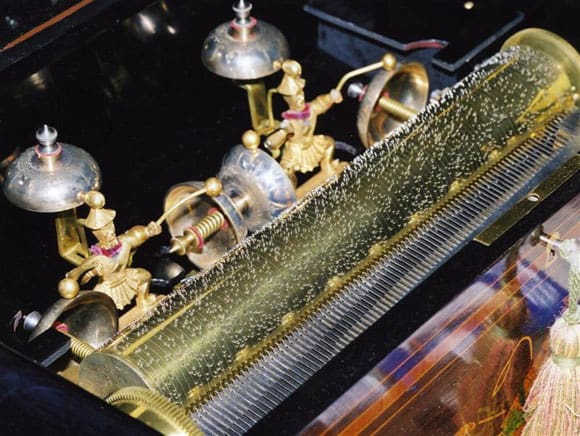
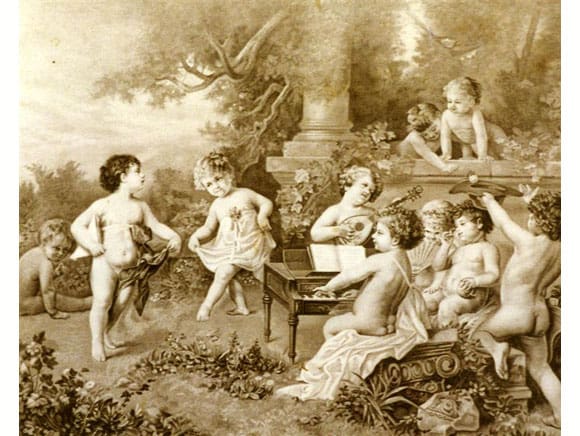
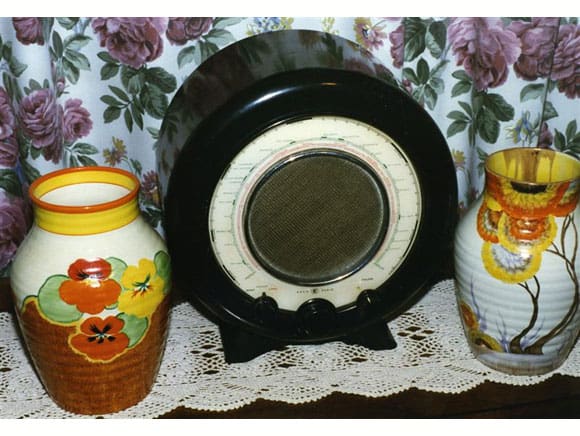
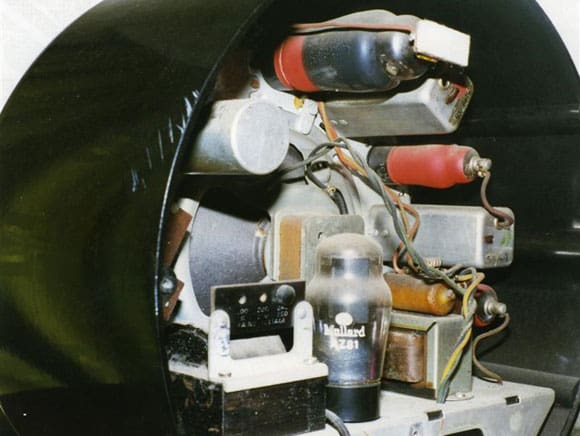
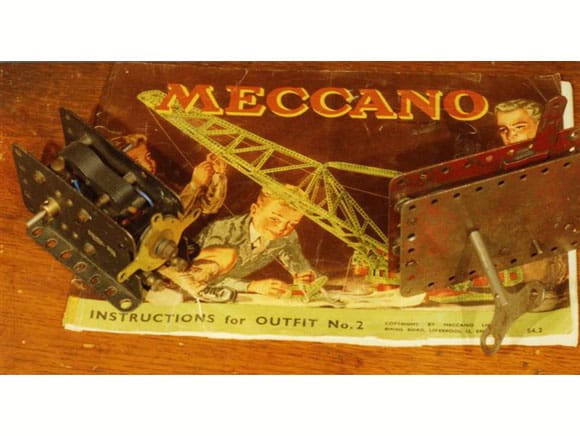
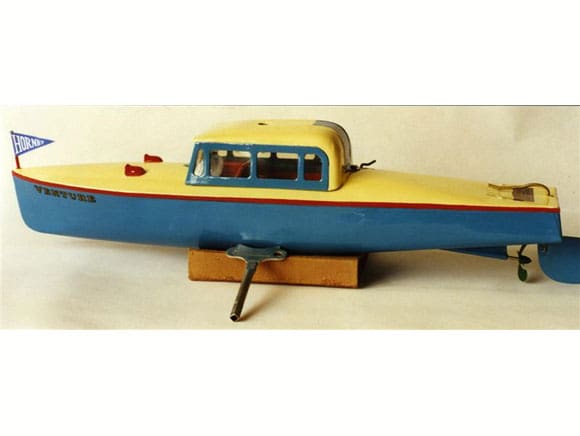
Pics 21 & 22: The movements and mechanical ideas used in early clocks were soon adapted by the makers of the first music making machines. The movement shown is by Bremond of Switzerland from the 19th century and the box top art is from a slightly later German Polyphon interchangeable music box. Pics 23 & 24: These are of a very collectable bakelite cased wireless receiver, Model A22 made by Ekco Radio Ltd of Southend on Sea. The radio is just post-war, but utilises pre war mouldings designed by Wells Coates. The two vases are also examples of art-deco design. Pics 25 & 26: These are two of the many hundreds made by Frank Hornby’s huge Meccano concern in Liverpool. The ‘Venture’ has been restored by John Hardy and the two spring motors are owned by John Dell.
And going shopping
Over the last 16+ years, I have collected and featured many items that were well outside of mainstream vintage model products, boats etc. in my pages. Often, these may have appeared to have somewhat obscure connections to r/c and engine technology.
For serious antiques
For example, how many modern r/c fans could make a connection between radio control and clocks? Yet there was a connection, for no early radio controlled model of any sort that could have operated without an ‘escapement’. This was an essential component of any mechanical clock ever made and the place where the idea for the first rubber or spring powered control mechanisms came from. So from time to time, antique clocks have appeared in my column, as have model control escapements.
In fact, anything with a ship or boat connection or anything with an interesting mechanism has been welcome through the door here at Collectors Corner and paintings, ceramics, silver and glass, have shared these pages with vintage gramophones, phonographs, musical boxes, radio and wireless transmitters and receivers etc. Above all, who would dare deny that without the bog standard pre-war domestic wireless set and the post-war ‘Tranny’, professionally developed both here and in the USA by firms like those in which I myself trained, there would be no radio control at all, for that is the simple truth. So I am finishing with a small and edited display of some of the nicer and more valuable objects pictured here at Collectors Corner over the years. I hope you enjoy seeing them once again.
Before bidding you all a fond farewell
Well, at long last, it really is time for me to depart these pages. I have had a good run, have corresponded with some most interesting people with similar interests from all over the World and have, notwithstanding the odd brickbat, had literally hundreds of compliments, been paid and thoroughly enjoyed the experience. I offer my thanks to all who have contributed to the later stages of this column, for without you it would have ended some years ago. Most of all I must thank my most supportive Editor, John Cundell. Thank you John and here’s wishing you many years of contented retirement. How about building and running another boat after all these years? I’ve got a few old cabin cruiser kits left in my sheds!
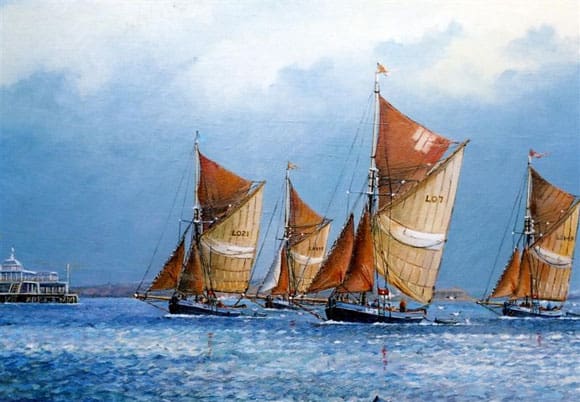
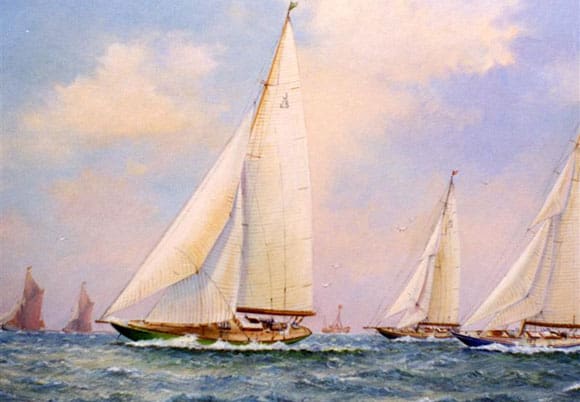
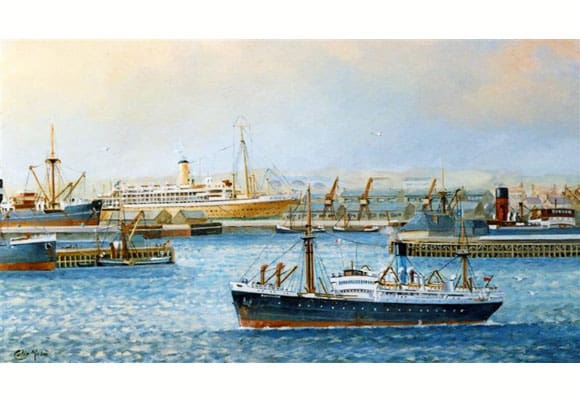
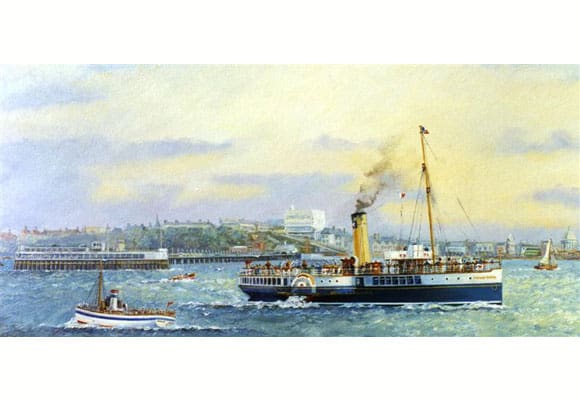
Pics 27 & 30: Two fine oils by Colin Moore are firstly, ‘Bawleys approach the Leigh Buoy off Southend Pier’ and the second is ‘Blue Flue off Tilbury’. Pics 28 & 29: Two more professional oils by Colin Moore. The first is of ‘J’ class yachts loom out of the mist off the Nore and the second is of the PS Medway Queen pulling away from Southend pier. Both are prints of the pictures by Nick Moore from the paintings by Colin Moore.
A ‘thank you’ too, for three nice and special people who helped get me started way back in 1992/3. Malcolm Brown who took my first photographs, Kay Turrell who did my artwork and John Dell who helped me rebuild all the old i.c. engines, that I’ve featured all these years. All were colleagues in my ‘day-job’ civil service career. Some of those restorations took a lot of years, didn’t they John, but well worth the wait? It is pleasant indeed that I have retained contact with all these friends over the last 16 years. I also had some initial help and encouragement from our hydroplane correspondent Peter Hill in my early days here at ‘Collectors Corner’ and I bought some of my first vintage copies of ‘Model Maker’ from his heap of ‘seconds’ and jolly useful they proved to be as well.
But my biggest ‘ thank you’ of all goes out to thousands of complete strangers. Yes, I mean you, my loyal and generous readers, for all the effort I have put into these 188 columns would have been utterly futile without you to read them. Farewell and ‘Happy vintage collecting and boating’ to you all. I hope one of you at least may take over, when I have finally laid down my trusty old (like everything in this column), Mac. Computer.
(This series does really end with the January 2008 issue, but Dave has prepared a mini-Collectors Corner that will commence in the spring of 2008, so nostalgia will be maintained! – Editor)



